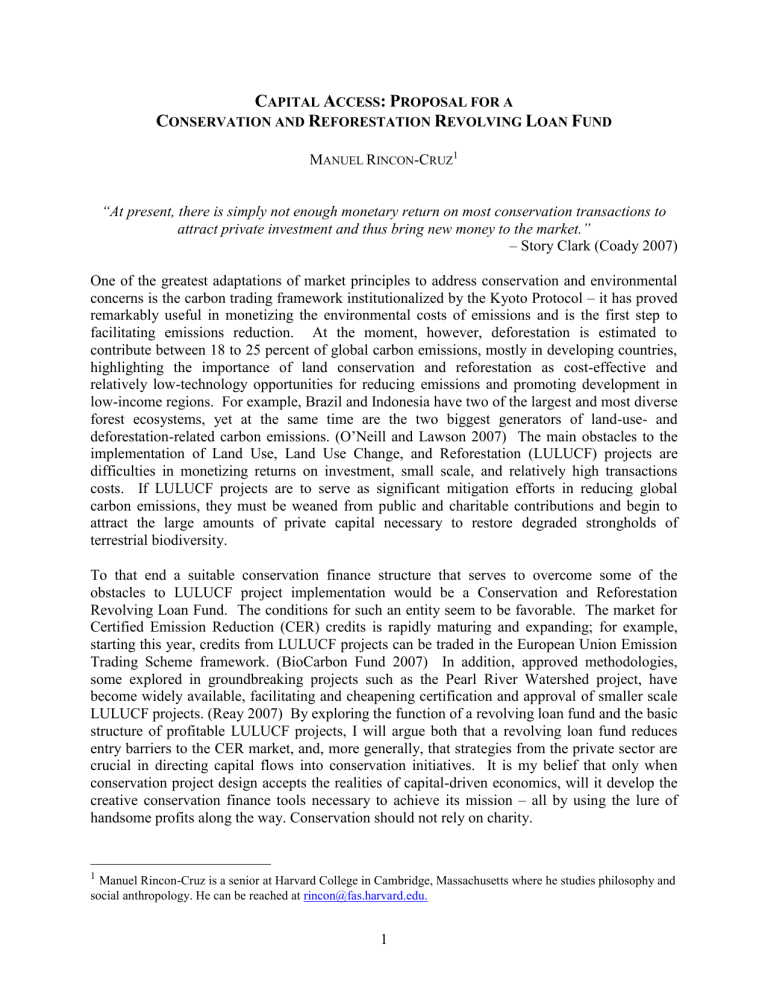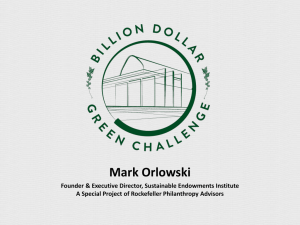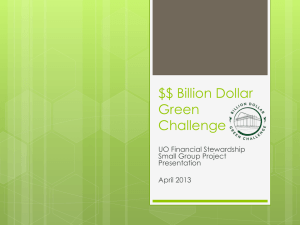Capital Access: Proposal for a Conservation and Reforestation

C APITAL A CCESS : P ROPOSAL FOR A
C ONSERVATION AND R EFORESTATION R EVOLVING L OAN F UND
M
ANUEL
R
INCON
-C
RUZ
1
“At present, there is simply not enough monetary return on most conservation transactions to attract private investment and thus bring new money to the market.”
– Story Clark (Coady 2007)
One of the greatest adaptations of market principles to address conservation and environmental concerns is the carbon trading framework institutionalized by the Kyoto Protocol – it has proved remarkably useful in monetizing the environmental costs of emissions and is the first step to facilitating emissions reduction. At the moment, however, deforestation is estimated to contribute between 18 to 25 percent of global carbon emissions, mostly in developing countries, highlighting the importance of land conservation and reforestation as cost-effective and relatively low-technology opportunities for reducing emissions and promoting development in low-income regions. For example, Brazil and Indonesia have two of the largest and most diverse forest ecosystems, yet at the same time are the two biggest generators of land-use- and deforestation-related carbon emissions. (O’Neill and Lawson 2007) The main obstacles to the implementation of Land Use, Land Use Change, and Reforestation (LULUCF) projects are difficulties in monetizing returns on investment, small scale, and relatively high transactions costs. If LULUCF projects are to serve as significant mitigation efforts in reducing global carbon emissions, they must be weaned from public and charitable contributions and begin to attract the large amounts of private capital necessary to restore degraded strongholds of terrestrial biodiversity.
To that end a suitable conservation finance structure that serves to overcome some of the obstacles to LULUCF project implementation would be a Conservation and Reforestation
Revolving Loan Fund. The conditions for such an entity seem to be favorable. The market for
Certified Emission Reduction (CER) credits is rapidly maturing and expanding; for example, starting this year, credits from LULUCF projects can be traded in the European Union Emission
Trading Scheme framework. (BioCarbon Fund 2007) In addition, approved methodologies, some explored in groundbreaking projects such as the Pearl River Watershed project, have become widely available, facilitating and cheapening certification and approval of smaller scale
LULUCF projects. (Reay 2007) By exploring the function of a revolving loan fund and the basic structure of profitable LULUCF projects, I will argue both that a revolving loan fund reduces entry barriers to the CER market, and, more generally, that strategies from the private sector are crucial in directing capital flows into conservation initiatives. It is my belief that only when conservation project design accepts the realities of capital-driven economics, will it develop the creative conservation finance tools necessary to achieve its mission – all by using the lure of handsome profits along the way. Conservation should not rely on charity.
1
Manuel Rincon-Cruz is a senior at Harvard College in Cambridge, Massachusetts where he studies philosophy and social anthropology. He can be reached at rincon@fas.harvard.edu.
1
P RINCIPLES OF A R EVOLVING L OAN F UND
A simple way of describing a revolving loan fund is as an entity that provides the lowest cost of capital to its borrowers, which often cannot access capital markets on their own. One example is the Texas Permanent School Fund, which can issues low-interest debt to investors and can thus pass on interest-rate savings in the form of low-interest loans to Texas school districts. This highlights three benefits of a revolving loan fund – low transaction cost, diversification of risk, and greater lending capacity. If each individual debtor issued its own debt the redundant overlap of transaction costs would make borrowing markedly more expensive; by consolidating access to the capital markets the revolving loan fund not only ensures timely and quick access to funds, but reduces the debt-issuance costs per debtor. A revolving loan fund can also offer low-interest bonds to investors because its debt is guaranteed by a diverse portfolio of loans to a large number of debtors, which reduces the risk of the loan fund defaulting on its obligations – a fund has reduced sensitivity to default by any one debtor. The enhanced lending capacity of a revolving loan fund comes from the ability to recycle received debt service payments into making new loans – thus the ‘revolving’ nature of the loaned capital. (McBryde et al., 2005)
A Conservation and Reforestation Revolving Loan Fund would work in the same way, albeit would offer some flexibility in implementation. Assuming the profitability of LULUCF projects, to be discussed below, the fund could accurately calculate LULUCF project revenues and thus set an appropriate loan interest rate. The flexibility comes into play in two scenarios. In the first, the loan fund is capitalized by national governments or international organizations; this emphasizes the revolving fund’s ability to create greater lending capacity. In the second scenario, the fund could repeatedly access capital markets on behalf of its clients (unlikely in the near future given financial market conditions). In this way the fund makes greater use of its ability to lower transactions costs and diversify risk to investors, and thus can lend at lower
2
interest rates. Emphasizing different strengths at different times is one way a revolving loan fund responds to global market conditions; accessing capital markets when interests are low, or recycling more funds when they are high. A revolving fund thus increases investment in land conservation, while at the same time remaining firm in promoting profitable conservation.
C
LEAN
D
EVELOPMENT
M
ECHANISM AND
LULUCF P
ROJECTS
The Clean Development Mechanism (CDM) clauses were added to the Kyoto Protocol as a way of ensuring flexibility for Annex 1 nations, the economically-developed countries, in meeting their carbon emission reduction targets. CDM is also meant to promote an efficient flow of capital, as investment will be made in countries where the reduction of emissions is cheaper than in an Annex 1 country. CDM works by setting the guidelines for projects in developing nations to earn CER’s, the official term for CDM-generated emission reduction credits, which can then be sold or traded back to the countries in need of meeting their emission reduction quotas. (Phat et al., 2004)
Although there is much to be said about CDM, such as the requirement for certification by a third party, limits on the extent to which CER’s can be used to meet reduction quotas, the establishment of baseline scenarios and additionality, it is useful to focus the discussion on
LULUCF and those features that make them suitable debtors to a revolving loan fund.
The first concern that might come to mind is that at this point in time LULUCF projects are just not profitable enough to support capital flows from the private sector. However, a closer analysis reveals this to not be the case. LULUCF projects are unique in that they can participate in two markets – the market for CER and the market for timber. Maximizing LULUCF profitability lies in the balancing of both revenue sources within the parameters of CDM and low-impact logging standards. (Gutierrez et al., 2007) An example of a detailed cost and profitability model for LULUCF projects is Carbomáx, which was tested in Columbia’s Forestry
Project in the Basin of the Chinchina River. (Gutierrez et al., 2007) In this case study, optimal levels of thinning and harvesting can be predicted in reference to CER and timber market prices.
Furthermore, the issue of selling CER’s is facilitated by programs such as the World Bank’s
BioCarbon Fund, which has purchased agreements with approved projects, paying annually or periodically upon verification by third party auditors. (BioCarbon Fund 2008)
Two points to keep in mind. First, LULUCF projects can be registered either as small-scale projects, which limits CER-eligible emissions reductions to 8 kt per year, or as a regular projects, which have no such limits. Profitable small-scale projects are limited to between 200 to 600 ha yet have lower transaction costs thanks to simpler guidelines, regulations, and registration for
CER transfers. On the other hand, larger projects benefit from economies of scale, although that benefit stops accruing after 8000 ha. (Gutierrez et al., 2007) Second, projects can now make use of approved methodologies for measuring emissions reductions, which previously represented serious bottlenecks in the approval and expansion of LULUCF projects. In recent years the
World Bank has helped in developing methodologies now adopted by the Executive Board supervising CDM, starting with the Pearl River Watershed Management Project in China.
(BioCarbon Fund 2007)
3
One example of all these pieces coming together in a LULUCF project is the Pico Bonito reserve in Honduras, where carbon credits are generated by planting native trees to capture, or sequester, carbon dioxide, credits which are later sold through the World Bank’s BioCarbon Fund. The ultimate goal is to establish a for-profit company, Pico Bonito Inc., to manage and own all
CER’s produced, and which has attracted a diversity of investors such as the Corporación
Hondureña de Desarrollo Forestal as well as local and international lenders, investors and landowners. (BioCarbon Fund n.d.) This is clear evidence that LULUCF can be profitable and can be analyzed just like any other business venture
O
VERCOMING
B
ARRIERS TO
P
RIVATE
S
ECTOR
P
ARTICIPATION
What is currently stopping the proliferation of such projects? LULUCF transactions have declined in terms of their share of total CER’s sold. The percentage of total emission reductions stemming from LULUCF projects has declined from 41 percent in the years 1996-1999 to seven percent in 2003, three percent in 2004, and one percent in 2005 and 2006. (BioCarbon Fund
2007) It has been recognized that the major social and institutional barriers to climate mitigation projects are high initial and transaction costs coupled with uncertain rates of return. (Zhang and
Aki 2001) But we have already established that LULUCF projects such as Pico Bonito can be profitable enterprises, with models accurately predicting creditworthiness, capital needs, and rates of return.
Perhaps the issue is made clear by the fact that almost all CDM investment funds, in aggregate of
$800 million, are focused on “providing a revenue stream rather than providing up-front project finance.” (Ellisa et al., 2007) In other words, there is a lack of the credit necessary for investments in LULUCF projects. It is here where the role of the revolving fund becomes obvious. As mentioned before, the main benefits of a revolving loan fund are low transaction costs, diversified risk, and greater lending capacity, all of which ultimately serve to augment the viability of land conservation initiatives.
C
ONCLUSION
The proposed Conservation and Reforestation Revolving Loan Fund highlights an important lesson in fulfilling the mission of sustainable development and environmental protection – the private sector must be engaged. Global society is at a stage where charitable organizations and limited government investment are not enough to mitigate all the risks inherent in climate change and resource degradation. Responsible individuals with concern for the environment’s future will find greatest use of their creativity in finding ways of adapting the rules and forces of financial markets to the needs of conservation.
4
W ORKS C ITED
BioCarbon Fund. About World Bank Carbon Finance Unit (CFU). http://carbonfinance.org/Router.cfm?Page=About&ItemID=24668 (accessed November 6,
2008).
BioCarbon Fund. BioCarbon Fund. Brochure, Cheverly: MOSAIC, 2007.
Honduras: Pico Bonito Forest Restoration. http://carbonfinance.org/Router.cfm?Page=BioCF&FID=9708&ItemID=9708&ft=Projects&Proj
ID=9637 (accessed November 6, 2008).
Coady, Patrick. "Search for Innovation: Reaching Out for Private Capital." Workshop Report,
New York City, 2007.
Ellisa, Jane, Harald Winkler, Jan Corfee-Morlot, and Frederic Gagnon-Lebrun. "CDM: Taking stock and looking forward." Energy Policy 35 (2007): 15-28.
Gutierrez, Victor Hugo, Mauricio Zapata, Carlos Sierra, Willaim Laguado, and Ali Santacruz.
"Maximizing the profitability of forestry projects under the Clean Development Mechanism using a forest management optimization model." Forest Ecology and Management 226 (2006):
341-350.
McBryde, Mary, Peter R Stein, and Story Clark. "External Revolving Loan Funds: Expanding
Interim Financing for Land Conservation." In Walden to Wall Street: Frontiers of Conservation
Finance, by James N. Levitt. Washington D.C.: Island Press, 2005.
O’Neill, Jim, and Sandra Lawson. "Things Are Heating Up: Economic Issues and Opportunities
From Global Warming." Goldman Sachs CEO Confidential, Feburary 8, 2007: 1-4.
Phat, Nophea Kim, Wolfgang Knorr, and Sophanarith Kim. "Appropriate measures for conservation of terrestrial carbon stocks: Analysis of trends of forest management in Southeast
Asia." Forest Ecology and Management 191 (2004): 283–299.
Reay, Dave. "Spring-time for sinks." Nature 446 (April 2007): 727-728.
Zhang, ZhongXiang, and Aki Maruyama. "Towards a private–public synergy in financing climate change mitigation projects." Energy Policy 29 (2001): 1363–1378.
5








